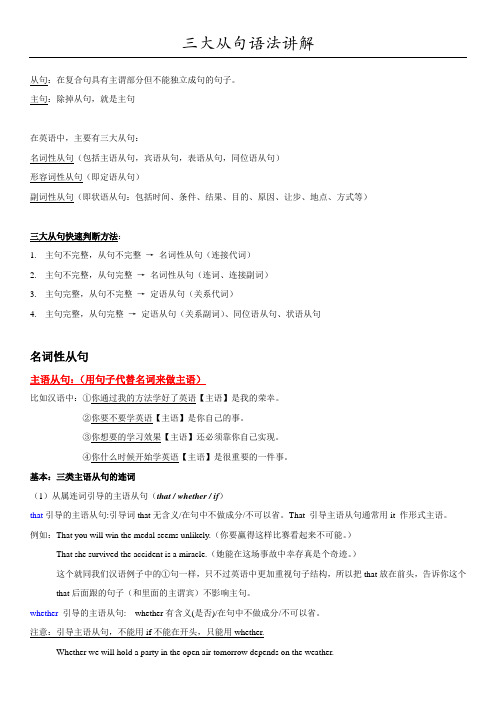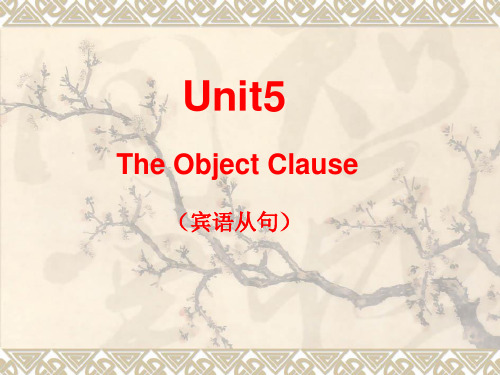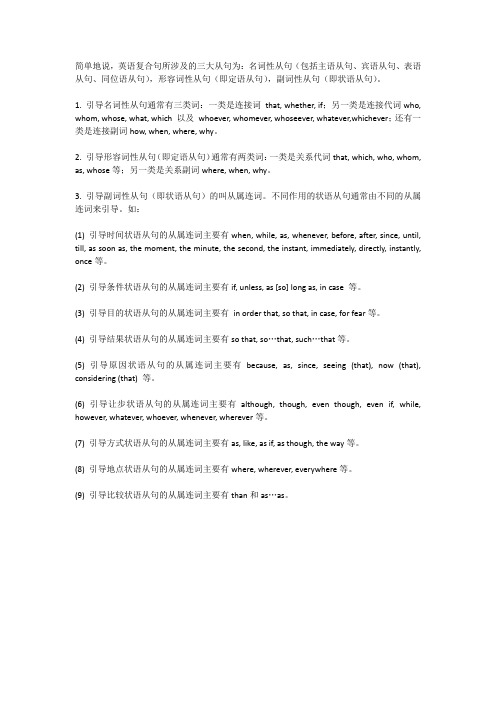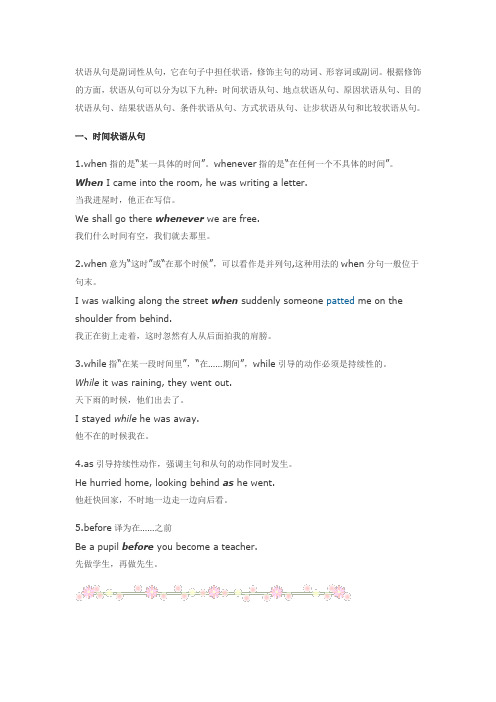复合句—副词性从句——状语从句
副词性从句状语从句

第三章状语从句状语从句种类多,但是含义易掌握时间地点及原因,目的条件和结果比较让步及方式,功能专一作状语。
状语从句学什么?首当其冲是连词引导连词怎么用?依据词义行得通。
特殊句型须牢记,考点往往于其中。
学习状语从句,首先有必要弄清以下几个概念或术语:1、什么是状语从句?在复合句中,修饰主句中的动词、形容词、副词等的从句就叫作状语从句。
由于状语从句起的是副词作用,因此,这种从句也可以称为副词性从句。
英语中的状语从句常见的有九种:时间状语从句、地点状语从句、原因状语从句、目的状语从句、条件状语从句、比较状语从句、让步状语从句、结果状语从句、方式状语从句。
在复合句中作时间状语的从句就叫时间状语从句,其他类推。
状语的从句的位置比较灵活,可以放在句首(主句之前),也可以放在句尾(主句之后)。
2、状语从句用什么样的词引导?不管是哪一种状语从句,都需要有一个词引导,这种引导词叫作连词,也可以叫作连接词或从属连词或关联词,我们称为连词。
引导状语从句的连词语较多,按照它们表示的含义可以分为九类:时间、地点、原因、目的、条件、比较、让步、结果、方式状语从句。
虽然不需要记住都有哪些连词可以引导状语从句,但是必须知道每个连词的词义,因为状语从句考查连词时,都是根据连词本身的词义来决定。
引导状语从句的连词不能省略。
、第一招:学会引导各种状语从句的连词的基本用法以及下面几组连词的比较:1、when\while\as2、till/until3、 immediately/directly/instantly/the moment(that)/the minute(that)/theinstant(that)/as soon as/hardly….when/no sooner….than/scarcely…..when/before.4、once…./as soon as5、as/because/since/for6、 since/when7、unless/if ..,..not8、as long as/so long as9、as far as/so far as10、although/though/as/while11、even though/even if 12、no matter what../whatever13、so…that/such….that14、so;….that/so that状语从句主要考查连词的选择。
三大从句语法讲解

三大从句语法讲解从句:在复合句具有主谓部分但不能独立成句的句子。
主句:除掉从句,就是主句在英语中,主要有三大从句:名词性从句(包括主语从句,宾语从句,表语从句,同位语从句)形容词性从句(即定语从句)副词性从句(即状语从句:包括时间、条件、结果、目的、原因、让步、地点、方式等)三大从句快速判断方法:1.主句不完整,从句不完整→名词性从句(连接代词)2.主句不完整,从句完整→名词性从句(连词、连接副词)3.主句完整,从句不完整→定语从句(关系代词)4.主句完整,从句完整→定语从句(关系副词)、同位语从句、状语从句名词性从句主语从句:(用句子代替名词来做主语)比如汉语中:①你通过我的方法学好了英语【主语】是我的荣幸。
②你要不要学英语【主语】是你自己的事。
③你想要的学习效果【主语】还必须靠你自己实现。
④你什么时候开始学英语【主语】是很重要的一件事。
基本:三类主语从句的连词(1)从属连词引导的主语从句(that / whether / if)that引导的主语从句:引导词that无含义/在句中不做成分/不可以省。
That 引导主语从句通常用it 作形式主语。
例如:That you will win the medal seems unlikely.(你要赢得这样比赛看起来不可能。
)That she survived the accident is a miracle.(她能在这场事故中幸存真是个奇迹。
)这个就同我们汉语例子中的①句一样,只不过英语中更加重视句子结构,所以把that放在前头,告诉你这个that后面跟的句子(和里面的主谓宾)不影响主句。
whether 引导的主语从句: whether有含义(是否)/在句中不做成分/不可以省。
注意:引导主语从句,不能用if不能在开头,只能用whether.Whether we will hold a party in the open air tomorrow depends on the weather.(我们明天会不会在户外举办聚会取决于天气。
The Object Clause

c.当that从句是双宾语中的直接宾语时, that不可 省。 e.g. I must never tell anyone that I could not see the cloth. d.当that宾语从句前有it作形式宾语时, that不 可省。 e.g. We think it important that we study hard.
1. We’d like to know which sentence is from the text. 2. The soldier would never forget what the general said to him. 3. No one was told about who should come in first. 4. The manager is interested in how his men has got over these difficulties. 5. Please tell me whose cup was broken this morning. 6. I want to know to whom you have given the money. 7. What he said is quite different from what we heard. 8. Make sure that the children are not late for school.
b.主句谓语动词是过去时态,从句谓语动词一 般需用过去的某种时态。(一般过去时、过 去进行时、过去将来时、过去完成时) e.g. I thought he studied hard. He said he was watching TV. They didn’t know when they would go to Beijing. She said she had finished the work.
英语中从句的连接词辨析

简单地说,英语复合句所涉及的三大从句为:名词性从句(包括主语从句、宾语从句、表语从句、同位语从句),形容词性从句(即定语从句),副词性从句(即状语从句)。
1. 引导名词性从句通常有三类词:一类是连接词that, whether, if;另一类是连接代词who, whom, whose, what, which 以及whoever, whomever, whoseever, whatever,whichever;还有一类是连接副词how, when, where, why。
2. 引导形容词性从句(即定语从句)通常有两类词:一类是关系代词that, which, who, whom, as, whose等;另一类是关系副词where, when, why。
3. 引导副词性从句(即状语从句)的叫从属连词。
不同作用的状语从句通常由不同的从属连词来引导。
如:(1) 引导时间状语从句的从属连词主要有when, while, as, whenever, before, after, since, until, till, as soon as, the moment, the minute, the second, the instant, immediately, directly, instantly, once等。
(2) 引导条件状语从句的从属连词主要有if, unless, as [so] long as, in case 等。
(3) 引导目的状语从句的从属连词主要有in order that, so that, in case, for fear等。
(4) 引导结果状语从句的从属连词主要有so that, so…that, such…that等。
(5) 引导原因状语从句的从属连词主要有because, as, since, seeing (that), now (that), considering (that) 等。
从句语法知识及真题解析

从句语法知识及真题解析从句语法知识及真题解析●复合句——形容词性(定语)从句1.尤其要注意whose的用法whose在从句中做定语,修饰名词。
所以,如果关系代词后面紧接的是名词,且关系代词又不在从句中做主语或宾语,那么,这个关系代词就应该是whose。
如:2.介词+ which的用法如果从句中主宾成分齐全,考生便可考虑关系代词是否在从句中做状语,而状语通常用介词短语充当,于是可以得知,关系代词前面应有介词,再分析所给的选项,根据与名词的搭配作出正确选择。
如:We are not conscious of the extent to which work provides the psychological satisfaction that can make the difference between a full and an empty life.3.as 与which用作关系代词的区别(1)as与the same, such, so, as等关联使用。
如:As the forest goes, so goes its animal life.(2)as和which都可以引导非限定性定语从句,但as在句中的位置比较灵活,可出现在句首、句中、句末,而which只能出现在句末,尤其是当先行词是整个句子时。
如:As is true in all institutions, juries are capable of making mistakes.As is generally accepted, economic growth is determined by the smooth development of production.常见的这类结构有:as has been said before, as has been mentioned above, as can be imagined, as is known to all, as has been announced, as can be seen from these figures, as might/could be expected, as is often the case, as has been pointed out, as often happens, as will be shown等。
状语从句在复合句中起状语作用的从句叫状语从句。有的状语

名词(这时他们是介词):
She waited a little while before making up her mind. 她等一会儿才做出决定。
After sending you that letter I recollected how stupid I was. 把信寄给你之后我想起我多么愚蠢。
其中的一个。
(4) for 也常引导表示原因的分句,但 for是并列连词,因此不能用于句首;for 提供的理由是一种补充性的说明,且 for 前常有逗号:
The days are short, for it is now December. 白天短了,因为已是12月了。 (四) 目的状语从句
引导目的状语从句的连词:in order that, so that(为了);for fear that, in case, lest(以免)等。
作相并发生,常可译作“一边……一边”:
When he returned, his wife was cooking. 他回来时,他妻子在烧饭。
While he was reading(或read), his wife was cooking(或cooked). 他看书时,他妻子一直烧饭。
As he was reading(或read), he was listening(或listened) to the radio. 他边看书边听广播。
1、 because, since, as 都可表示“因为”。
(1) because 表示原因的语气最强, 通常回答以疑问词why 引导的问句,除 特别强调外,该从句一般位于主句后; since 表示稍加分析后而推断出来的原 因,比as 正式;as 表示对方已知道的原 因。since 和 as 不回答why 引导的疑问 句,而且其从句一般放在句首:
复合句---状语从句

复合句 状语从句
定义
在复合句中修饰主句中的动词、形容词或副词,起状语作用 的从句叫状语从句。状语从句可置主句之前,也可置主句之 后。前置时,从句后用逗号与主句分开;后置时,与主句之 间无标点符号。
复合句 状语从句
复合句 状语从句
1.时间状语从句
(1)引导词:when, while, as, before, after, as soon as, until, since. (2)主句为将来时,从句用一般现在时代替。这就是我们常 说的“主将从现”。 如:Please call me when you get there. I will write to you as soon as I arrive in Beijing. (3) not...until的同义句替换。(before, after, when)
复合句 状语从句
3.原因状语从句
(4)Because , since,as, for的区别: because 从句所表示的是对方不知道的直接的原因,因此在 回答以why引导的特殊疑问句时只可用because; as,since从 句所表示的往往是对方已知的原因;for往往用于附加理由证 明或推断的结果。 Since everyone is here, let’s start our discussion. Spring is here, for the flowers are blooming(开花).
复合句 状语从句
上海历年真题
D we 5.We will have no water to drink ______ don’t protect the earth.—2010 A.until B. before C. though D. if
状语从句是副词性从句

状语从句是副词性从句,它在句子中担任状语,修饰主句的动词、形容词或副词。
根据修饰的方面,状语从句可以分为以下九种:时间状语从句、地点状语从句、原因状语从句、目的状语从句、结果状语从句、条件状语从句、方式状语从句、让步状语从句和比较状语从句。
一、时间状语从句1.when指的是“某一具体的时间”。
whenever指的是“在任何一个不具体的时间”。
When I came into the room, he was writing a letter.当我进屋时,他正在写信。
We shall go there whenever we are free.我们什么时间有空,我们就去那里。
2.when意为“这时”或“在那个时候”,可以看作是并列句,这种用法的when分句一般位于句末。
I was walking along the street when suddenly someone patted me on the shoulder from behind.我正在街上走着,这时忽然有人从后面拍我的肩膀。
3.while指“在某一段时间里”,“在……期间”,while引导的动作必须是持续性的。
While it was raining, they went out.天下雨的时候,他们出去了。
I stayed while he was away.他不在的时候我在。
4.as引导持续性动作,强调主句和从句的动作同时发生。
He hurried home, looking behind as he went.他赶快回家,不时地一边走一边向后看。
5.before译为在……之前Be a pupil before you become a teacher.先做学生,再做先生。
6.after译为在……之后He arrived after the game started.比赛开始后,他到了。
7.如主句动词是持续性动作,常用肯定式,表示“直到……为止”。
